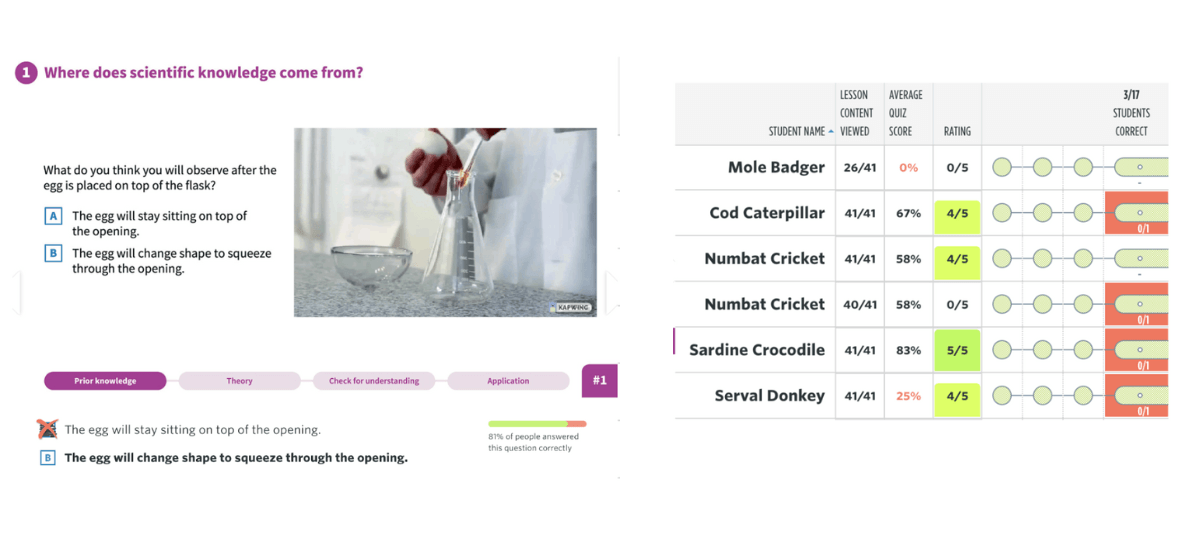Catering for a wide range of abilities in junior secondary Maths and Science
So many junior secondary Maths and Science teachers tell us their class includes a very wide range of student abilities - only further exacerbated by disruptions in learning the past few years.
Our junior secondary Maths and Science resources have been built with exactly this challenge in mind. Whether it’s catering for students struggling, or extending high ability students, and everything in between! So here’s a quick guide to cater for this range of literacy and numeracy abilities, meet students at their point of need and save yourself time creating resources.
Ideas for Maths
Choose when to use the Understanding Worksheet
Teachers can print the worksheet for each lesson, for students to complete prior to the set questions. In your planning, ask yourself - do I need to print this for every concept? For every student? Perhaps just a handful of students do the worksheet in the lessons and the stronger students skip the worksheet and start with medium questions?
In Maths, maybe everyone starts with the fluency questions in lessons, and you only hand out the worksheet if students are really struggling? In Science, you could use this worksheet with every student to gauge where their starting point is.

Teacher-led differentiation
Have you done a pre-test and identified students’ strengths and weaknesses in a given topic? Based on this, divide your class into 3 groups for the topic - those who begin with the worksheet and mild fluency questions, those who can start with the medium fluency questions, those who can start with the spicy fluency questions and move into problem-solving sooner.
Student-led differentiation
Ask all students to start with the mild fluency questions. When students get 2 of these correct, they move on to the medium questions. When students get 2 of these correct, they move on to the spicy questions, and ultimately they might even tackle the extra spicy questions.
Divide a topic test, multiply your options
Quickly and easily edit a chapter test to set more different assessment tasks for different groups of students in your class/year level. The chapter tests are fully editable, so you can tailor assessments to match students’ ability levels.
Use video lessons as a pre-test
Edrolo video lessons include a multi-choice question for every concept covered. Set the video lesson as pre-learning, then use the teacher data to identify which concept was most challenging. You can then focus on this in your next lesson, meeting head-on most students’ biggest knowledge-gap when teaching a concept.
In-class independent learning
Do students have devices in class? Have students use the video solutions to check for their understanding before raising their hand, freeing-up teacher time to cater for students with additional needs.
Ideas for Science
Differentiated Theory Review Question Sets
Like the Maths resource, our Science resources have been designed to address the broad spectrum of needs in the Junior classroom. With students coming into high school with different primary school experiences of science, they come in with varying levels of prior knowledge. To help address this and bridge the gap, we've designed our question sets with different levels of spiciness so you and your students can be challenged at their level. We've also given you editable word doc versions of this so you can customise worksheets to suit your lessons.
Want to build a growth mindset in your classroom and help deconstruct the fear and stigma around 'not being good at something'? Get your students choosing their spiciness levels each class and teach them that their starting point may change depending on what they are familiar with. The more you do this and talk about this, the less daunting it becomes!

Skill Sharpener Activities
If you've ever found that your students need more practice with certain key science skills then look no further than the skill sharpener activities. Designed to specifically up-skill students (no pun intended!)- you can use these for whole class activities or target certain skills with different groups of students based on their needs.
Designed to be flexible, you can get your students to complete these actvities online (super great for keeping track of things for reporting), use the google doc to share with your class OR print it off.

Skills in Context
If you teach senior students you will be all too familiar with students struggling with application style questions that have foreign contexts and saying things like "but we didn't learn this!" (when they certainly did), then we've got you covered. We're giving students early exposure to skills in context tasks where students can apply their learning to unfamiliar contexts. Help build your students' confidence to tackle any task to master their junior and senior years!

We've also included our spiciness ratings on these questions to allow for easier differentiation across the class. Student's will be exposed to various modes of data with strong theorectical links to the curriculum (just in different contexts of course!).
Differentiated revision
Have you ever worked through a topic and found that your students picked things up at different rates? Or by the time your summative assessment rolled around, each student needed different revision strategies and questions? The Chapter Review questions have been divided into different spiciness categories based on question difficulty. That way, your or your students can select the spiciness that best suits their needs.

Use the online slides to review prior knowledge
Students can work through the lesson slides online, watch embedded videos, check and then rate their understanding prior to coming to class. Teachers can then use the lesson grid to review students' answers, determine difficult concepts for the class, review student notes and self-ratings to plan future lessons and group students as required.

Looking for more ideas to cater to a wide range of abilities in your junior Maths or Science classes? Our resources come pack with features that make differentiation and catering for mixed abilities easy, while saving teacher prep time. Differentiated questions, student worksheets, clear teacher theory (videos in Maths and editable slides in Science), and fully worked video solutions, so students can make progress in class or at home.

